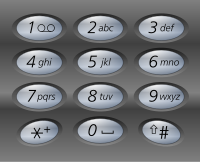Leetcode #0017
Question Prompt
from https://leetcode.com/problems/letter-combinations-of-a-phone-number/

Credit: Wikimedia / CC.
Given a string containing digits from 2-9 inclusive, return all possible letter combinations that the number could represent.
A mapping of digit-to-letters (just like on the telephone buttons depicted on the right) is given below. Note that 1 does not map to any letters.
Example
Input: "23"
Output: ["ad", "ae", "af", "bd", "be", "bf", "cd", "ce", "cf"]
Note Although the above answer is in lexicographical order, your answer could be in any order you want.
Solution
Let's write code to solve a specific example, then generalize it and put it into a function.
telephone = {
2 : 'abc',
3 : 'def',
4 : 'ghi',
5 : 'jkl',
6 : 'mno',
7 : 'pqrs',
8 : 'tuv',
9 : 'wxyz'
}
strCombos = []
I'll be using the backtracking (aka backtracing) approach here, an algorithm is very similar to the depth-first search algorithm used to traverse graphs. Backtracking is an algorithm to explore the entire solution space; when a candidate solution is determined to be invalid, it's discarded and we take a step backwards and change direction (i.e., make a different decision). In this case, we're backtracking with no constraint.
Our approach will be recursive. Our function backtrace(strCombo, remDigits) will take two arguments, the current string stem strCombo and the remaining digits remDigits. The function will
-
select out the next digit from
remDigits, and its associated letter mapping. -
for every letter
jin that mapping, callbactrace()onstrCombo + jand the remaining digitsremDigits[1:]. -
the base case will be when remDigits is empty; at that point the current solution is complete and can be appended to the ongoing list of solutions,
strCombos(defined outside of the function).
def backtrace(strCombo, remDigits):
"""
:type strCombo: str
:type remDigits: str
:rtype: List[str]
"""
# base case
if not remDigits:
# if there are no more digits,
# append to the list of string combinations
# and exit
strCombos.append(strCombo)
return True
else:
# otherwise, identify letters associated
# with current digit and continue on to the next
digit = int(remDigits[0])
for j in telephone[digit]:
print('appending ' + j + ' to ' + strCombo)
print('running solutions for remaining digits ' + \
str(remDigits[1:]))
backtrace(strCombo + j, remDigits[1:])
backtrace('', '23')
appending a to
running solutions for remaining digits 3
appending d to a
running solutions for remaining digits
appending e to a
running solutions for remaining digits
appending f to a
running solutions for remaining digits
appending b to
running solutions for remaining digits 3
appending d to b
running solutions for remaining digits
appending e to b
running solutions for remaining digits
appending f to b
running solutions for remaining digits
appending c to
running solutions for remaining digits 3
appending d to c
running solutions for remaining digits
appending e to c
running solutions for remaining digits
appending f to c
running solutions for remaining digits
strCombos
['ad', 'ae', 'af', 'bd', 'be', 'bf', 'cd', 'ce', 'cf']
🎉 🎉 🎉 Great! Now that we have something that seems to work, let's remove the print() statements and enclose our code in our definition of the Solution class.
This code is also available within a GitHub Gist.
class Solution:
def __init__(self):
self.telephone = {
2 : 'abc',
3 : 'def',
4 : 'ghi',
5 : 'jkl',
6 : 'mno',
7 : 'pqrs',
8 : 'tuv',
9 : 'wxyz'
}
def letterCombinations(self, digits):
def backtrace(strCombo, remDigits):
# base case
if not remDigits:
# if there are no more digits,
# append to the list of string combinations
# and exit
strCombos.append(strCombo)
return True
else:
# otherwise, identify letters associated
# with current digit and continue on to the next
digit = int(remDigits[0])
for j in telephone[digit]:
backtrace(strCombo + j, remDigits[1:])
strCombos = []
if digits:
backtrace('', digits)
return strCombos
Solution().letterCombinations('23')
['ad', 'ae', 'af', 'bd', 'be', 'bf', 'cd', 'ce', 'cf']
Solution().letterCombinations('92')
['wa', 'wb', 'wc', 'xa', 'xb', 'xc', 'ya', 'yb', 'yc', 'za', 'zb', 'zc']